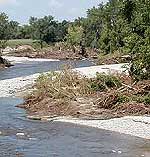By Bob Reha
Minnesota Public Radio
July 18, 2002
Flooding in northwest Minnesota has become a regular event. Twice this year heavy rains have wiped out crops, swept away roads and destroyed bridges. For people who live here it's a frustrating situation. Some say money spent on cleanup and relief might be better invested in flood prevention efforts.
| |
|
|
|
||
As you drive on Highway 9, near Borup, Minn., it's easy to see the signs of high water. Fields are clogged with silt. Crops rot in the fields. And there are clouds of black mosquitoes.
Mark Harless gets out of his pickup truck and strolls towards a gigantic brush pile. Harless points to recent flood damage.
"We're at the Highway 9 bridge, where the South Branch of the Wild Rice River comes under here, and you can see the approaches on both sides of the river are completely washed out," he says.
Harless estimates one-quarter of the 4,400 acres he planted this spring are destroyed. He has crop insurance, but says that won't help much. He bristles when the recent floods are described as 100-year events.
"In 1966, we had water come over the highway here," he begins. "(In) 1969, we had water come over the highway. In 1975, my father-in-law lost his entire crop. In 1997, of course, the big flood in the spring, and 2000 we had major flooding here very similar to what's happened this year," Harless continues.
| |
|
|
|
||
Harless's farm sits in the central region of the Wild Rice River basin. The land here is flat, with rich black soil, ripe for farming. Upstream, the Wild Rice flows through rolling hills. Those hills act like a feeder pipe. Harless says when heavy rains soak the area, he gets hit. The river's channel is heavily silted, so there's no place for the water to go except downhill.
"Right now, we are the flood retention project," says Harless. "Our farm fields are the flood retention project - everybody along this river from here to Hendrum is the flood retention project - and we're not getting compensated for it. It's everybody's water."
Harless says the solution to the flooding is dams along the river. He'd like to see a regional tax to build the dams. He says that couldn't be any more expensive then the money spent on cleanup and disaster relief.
Jim Stordahl, a regional educator for the University of Minnesota Extension Service, says federal farm policy is part of the problem. Stordahl says federal programs have encouraged farmers to drain every available acre.
"And plant everything you can into wheat and soybeans, or in some areas a few other crops," says Stordahl. "I think this is really now a symptom of some flaws in our farm policy."
| |
|
|
|
||
Stordahl says the government pays farmers to tile and drain every acre they can. That, combined with low crop prices, means farmers are planting every acre they can. And there are other problems.
Getting people to agree on what type of flood control projects are needed is a rough task. Farmer Mark Harless advocates a series of dams on the river that would hold flood waters for a short period of time. But getting the necessary permit for a dam is no easy task.
A 1975 proposal to dam the Wild Rice River near Twin Valley went nowhere. The resulting controversy lasted 15 years, before the idea was finally abandoned.
In an effort to avoid future conflicts, state, federal and local officials are working more closely with each other. Paul Swenson, regional director of the Minnesota DNR, says if flood mitigation is going to happen in the Wild Rice Basin, compromise is essential.
"We need $100 million in flood control money in the Wild Rice watershed alone. And in order to be able to get the money, we have to be able to build projects that have multiple benefits," says Swenson. "If they benefit water quality for the people downstream, if it creates fish and wildlife habitat, that makes it that much easier to get the money and to get the permits that are needed."
Swenson says it will take time - up to 15 years - before flood control projects on the Wild Rice are a reality. That's not quick enough for Mark Harless. He thinks he and his neighbors should be compensated for storing flood water.
More from MPR


